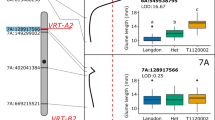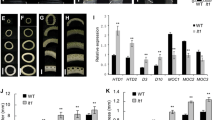Abstract
Vegetative axillary meristem (AXM) activity results in the production of branches. In barley (Hordeum vulgare L.), vegetative AXM develop in the crown and give rise to modified branches, referred to as tillers. Mutations in the barley low-tillering mutant uniculm2 block vegetative AXM development and prevent tiller development. The objectives of this work were to examine gene expression in wild-type and cul2 mutant plants, fine map the CUL2 gene, and to examine synteny in the CUL2 region in barley with rice. RNA profiling experiments using two near-isogenic line pairs carrying either the cul2 mutant allele or wild-type CUL2 allele in different genetic backgrounds detected 28 unique gene transcripts exhibiting similar patterns of differential accumulation in both genetic backgrounds, indicating that we have identified key genes impacted by the CUL2 gene. Twenty-four genes had higher abundance in uniculm2 mutant tissues, and nearly half of the annotated genes likely function in stress-response or signal transduction pathways. Genetic mapping identified five co-segregating markers in 1,088 F2 individuals. These markers spanned the centromere region on chromosome 6H, and coincided with a 50-cM region on rice chromosome 2, indicating that it may be difficult to positionally clone CUL2. Taken together, the results revealed stress response and signal transduction pathways that are associated with the CUL2 gene, isolating CUL2 via positional cloning approaches that may be difficult, and the remnants of barley–rice synteny in the CUL2 region.


Similar content being viewed by others
References
Babb S, Muehlbauer GJ (2003) Genetic and morphological characterization of the barley uniculm2 (cul2) mutant. Theor Appl Genet 106:846–857
Beveridge CA, Mathesius U, Rose RJ, Gresshoff PM (2007) Common regulatory themes in meristem development and whole-plant homeostasis. Curr Opin Plant Biol 10:44–51
Boddu J, Cho S, Kruger WM, Muehlbauer GJ (2006) Transcriptome analysis of the barley–Fusarium graminearum interaction. Mol Plant Microbe Interact 19:407–417
Cho S, Garvin DF, Muehlbauer GJ (2006) Transcriptome analysis and physical mapping of barley genes in wheat–barley chromosome addition lines. Genetics 172:1277–1285
Close TJ, Wanamaker SI, Caldo RA, Turner SM, Ashlock DA, Dickerson JA, Wing RA, Muehlbauer GJ, Kleinhofs A, Wise RP (2004) A new resource for cereal genomics: 22 K barley GeneChip comes of age. Plant Physiol 134:960–968
Close TJ, Bhat PR, Lonardi S, Wu Y, Rostoks N, Ramsay L, Druka A, Stein N, Svensson JT, Wanamaker S et al (2009) Development and implementation of high-throughput SNP genotyping in barley. BMC Genomics 10:582
Dabbert T, Okagaki RJ, Cho S, Boddu J, Muehlbauer GJ (2009) The genetics of barley low-tillering mutants: absent lower laterals (als). Theor Appl Genet 118:1351–1360
Dabbert T, Okagaki RJ, Cho S, Heinen S, Boddu J, Muehlbauer GJ (2010) The genetics of barley low-tillering mutants: low number of tillers-1 (lnt1). Theor Appl Genet 121:705–717
Domagalska MA, Leyser (2011) Signal integration in the control of shoot branching. Nat Rev Mol Cell Biol 12:211–221
Druka A, Franckowiak J, Lundqvist U, Bonar N, Alexander J, Houston K, Radovic S, Shahinnia F, Vendramin V, Morgante M, Stein N, Waugh R (2011) Genetic dissection of barley morphology and development. Plant Physiol 155:617–627
Durbak A, Yao H, McSteen P (2012) Hormone signaling in plant development. Curr Opin Plant Biol 15:92–96
Dworkin I, Kennerly E, Tack D, Hutchinson J, Brown J, Mahaffey J, Gibson G (2009) Genomic consequences of background effects on scalloped mutant expressivity in the wing of Drosophila melanogaster. Genetics 181:1065–1076
Elshire RJ, Glaubitz JC, Sun Q, Poland JA, Kawamoto K, Buckler ES, Mitchell SE (2011) A robust, simple genotyping-by-sequencing (GBS) approach for high diversity species. PLoS One 6:e19379
Irizarry RA, Hobbs B, Collin F, Beazer-Barclay YD, Antonellis KJ, Scherf U, Speed TP (2003) Exploration, normalization, and summaries of high density oligonucleotide array probe level data. Biostatistics 4:249–264
Islam AKMR, Shepherd KW (1990) Incorporation of barley chromosomes in wheat. In: Bajaj YPS (ed) Biotechnology in agriculture and forestry, vol 13. Springer, Berlin, pp 128–151
Jia H, Nettleton D, Peterson JM, Vazquez-Carrillo G, Jannink J-L, Scott MP (2007) Comparison of transcript profiles in wild-type and o2 maize endosperm in different genetic backgrounds. Plant Genome 47:S45–S59
Künzel G, Korzun L, Meister A (2000) Cytologically integrated physical restriction fragment length polymorphism maps for the barley genome based on translocation breakpoints. Genetics 154:397–412
Li X, Qian Q, Fu Z, Wong Y, Xiong G, Zeng D, Wang X, Liu X, Teng S, Hiroshi F, Yuan M, Luo D, Han B, Li J (2003) Control of tillering in rice. Nature 422:618–621
Lundqvist U, Franckowiak J, Konishi T (1997) New and revised descriptions of barley genes. Barley Genetics Newsletter 26:22
Mayer FX, Martis M, Hedley PE, Simková H, Liu H, Morris JA, Steuernagel B, Taudien S, Roessner S, Gundlach H et al (2011) Unlocking the barley genome by chromosomal and comparative genomics. Plant Cell 23:1249–1263
McSteen P (2009) Hormonal regulation of branching in grasses. Plant Physiol 149:46–55
McSteen P, Leyser O (2005) Shoot branching. Ann Rev Plant Biol 56:353–374
Muñoz-Amatriaín M, Moscou MJ, Bhat PR, Svensson JT, Bartoš J, Suchánková P, Šimková H, Endo TR, Fenton RD, Lonardi S et al (2011) An improved consensus linkage map of barley based on flow-sorted chromosomes and SNP markers. Plant Genome 4:238–249
Odland W, Baumgarten A, Phillips R (2006) Ancestral rice blocks define multiple related regions in the maize genome. Plant Genome 1:S41–S48
Rozen S, Skaletsky HJ (2000) Primer3 on the WWW for general users and for biologist programmers. In: Krawetz S, Misener S (eds) Bioinformatics methods and protocols: methods in molecular biology. Humana, Totowa, NJ, pp 365–386
Sato K, Nankaku N, Takeda K (2009) A high-density transcript linkage map of barley derived from a single population. Heredity 103:110–117
Schmitz G, Theres K (2005) Shoot and inflorescence branching. Curr Opin Plant Biol 8:506–511
Shahinnia F, Druka A, Franckowiak J, Morgante M, Waugh R, Stein N (2012) High resolution mapping of Dense spike-ar (dsp.ar) to the genetic centromere of barley chromosome 7H. Theor Appl Genet 124:373–384
Shands RG (1963) Inheritance and linkage of orange lemma and uniculm characters. Barley Genet Newslett 6:35–36
The International Brachypodium Initiative (2010) Genome sequencing and analysis of the model grass Brachypodium distachyon. Nature 463:763–768
Thiel T, Graner A, Waugh R, Grosse I, Close TJ, Stein N (2009) Evidence and evolutionary analysis of ancient whole-genome duplication in barley predating the divergence from rice. BMC Evol Biol 9:209
Throude M, Bolot S, Bosio M, Pont C, Sarda X, Quraishi UM, Bourgis F, Lessard P, Rogowsky P, Ghesquiere A, Murigneux A, Charmet G, Perez P, Salse J (2008) Structure and expression analysis of rice paleo duplications. Nucl Acids Res 37:1248–1259
van Leeuwen H, Kliebenstein DJ, West MAL, Kim K, van Poecke R, Katagiri F, Michelmore RW, Doerge RW, St. Clair DA (2007) Natural variation among Arabidopsis thaliana accessions for transcriptome response to exogenous salicylic acid. Plant Cell 19:2099–2110
Van Ooijen JW (2006) JoinMap® 4, Software for the calculation of genetic linkage maps in experimental populations. Kyazma, Wageningen
Xu WW, Cho S, Yang SS, Bolon Y-T, Bilgic H, Jia H, Xiong Y, Muehlbauer GJ (2009) Single-feature polymorphism discovery by computing probe affinity shape powers. BMC Genet 10:48
Yan H, Talbert PB, Lee HR, Jett J, Henikoff S, Chen F, Jiang J (2008) Intergenic locations of rice centromeric chromatin. PLoS Biol 6:e286
Zhang Z-B, Yang G, Arana F, Chen Z, Li Y, Xia H-Y (2007) Arabidopsis inositol polyphosphate 6-/3-kinase (AtIpk2β) is involved in axillary shoot branching via auxin signaling. Plant Physiol 144:942–951
Zhou D, Zhou X, Ling Y, Zhang Z, Su Z (2010) agriGO: a GO analysis toolkit for the agricultural community. Nucl Acids Res 38:W64–W70
Acknowledgments
We thank J. Franckowiak, Department of Plant Sciences, North Dakota State University, Fargo, ND, for generously providing us seed for Bowman cultivar, and D. Rasmusson, Department of Agronomy and Plant Genetics, University of Minnesota, St. Paul, MN, for seed for the Morex and Steptoe cultivars. Morex-cul2 was provided to us by Steve Dofing at Washington State University, Pullman, WA; Bowman-cul2 and cul2-rob1 were obtained from the USDA–ARS National Small Grain Germplasm Research Facility, Aberdeen, ID. Maria Muñoz-Amatriaín, Department of Agronomy and Plant Genetics, University of Minnesota, St. Paul, MN, generously provided us with the updated barley SNP map data prior to publication. The University of Minnesota Supercomputing Institute for Advanced Computational Research provided computational resources, and GeneChip hybridizations were performed at the University of Minnesota BioMedical Genomics Center. This research was supported by a grant from the United States Department of Agriculture CSREES–NRI Plant Growth and Development program grant #2004-03440 to GJM.
Author information
Authors and Affiliations
Corresponding author
Electronic supplementary material
Below is the link to the electronic supplementary material.
Fig. S1
Hierarchical clustering analysis of transcript patterns. Abundance patterns for individual samples from the different tissue types in wild-type barley and the cul2 mutant: a Morex and Morex-cul2, b Bowman and Bowman-cul2 (JPEG 92 kb)
Fig. S2
GO analysis of transcripts up-regulated in Bowman-cul2 versus Bowman. Up-regulated GO transcript categories that were over-represented in Bowman-cul2 versus Bowman were identified using the Singular Enrichment Analysis tool at AgriGO (http://www.bioinfo.cau.edu.cn/agriGO/. This figure does not include GO categories relating to cellular localization (JPEG 56 kb)
Fig. S3
GO analysis of transcripts up-regulated in Morex-cul2 versus Morex. Up-regulated GO transcript categories that were over-represented in Morex-cul2 versus Morex were identified using the Singular Enrichment Analysis tool at AgriGO (http://www.bioinfo.cau.edu.cn/agriGO/(JPEG 57 kb)
Table 1
Markers used for mapping (DOC 80 kb)
Table 2
Correlation coefficients of transcript abundance in four tissues (DOC 62 kb)
Table 3
Transcripts with at least 2-fold accumulation differences in mutant cul2 tissue compared to wild-type in the Morex background (XLS 280 kb)
Table 4
Transcripts with at least 2-fold accumulation differences in mutant cul2 tissue compared to wild-type in the Bowman background(XLS 302 kb)
Rights and permissions
About this article
Cite this article
Okagaki, R.J., Cho, S., Kruger, W.M. et al. The barley UNICULM2 gene resides in a centromeric region and may be associated with signaling and stress responses. Funct Integr Genomics 13, 33–41 (2013). https://doi.org/10.1007/s10142-012-0299-7
Received:
Revised:
Accepted:
Published:
Issue Date:
DOI: https://doi.org/10.1007/s10142-012-0299-7




